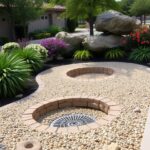Dry riverbeds can be a fantastic focal point in your yard, adding both charm and a touch of nature’s beauty. If you’re looking to spruce up your outdoor space, check out these 23 landscaping ideas that incorporate dry riverbeds in creative and functional ways. From stylish stone arrangements to vibrant plantings, there’s something here for every taste and garden size.
Drought-Resistant Plant Arrangements
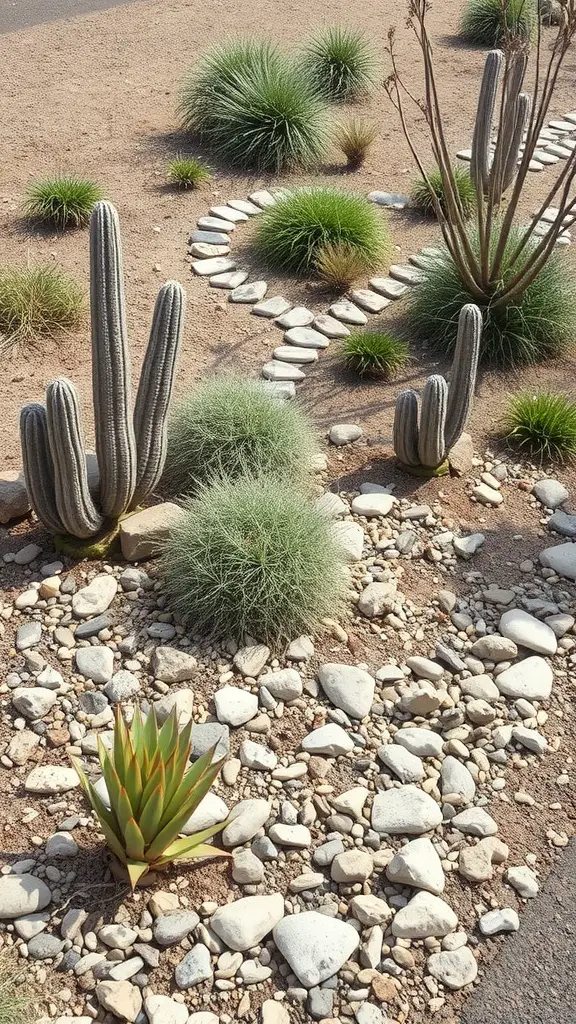
Creating a drought-resistant landscape can be both practical and beautiful. The image showcases a stunning arrangement of plants that thrive in dry conditions. Notice the tall, slender cacti standing proudly alongside soft, green grasses. These plants are not just visually appealing; they are also low-maintenance and require minimal water.
The use of stones and pebbles in the design adds texture and helps with drainage. This setup mimics a natural desert environment, making it a perfect choice for those looking to conserve water while enjoying a lovely outdoor space. The winding path of stones invites you to explore the arrangement, making it not just a garden but a little journey through nature.
Incorporating various heights and textures, like the spiky cacti and the fluffy grasses, creates visual interest. You can easily replicate this look by choosing native plants that are adapted to your local climate. This way, you can enjoy a vibrant garden without the stress of constant watering.
Succulent Rock Gardens

Succulent rock gardens are a fantastic way to add color and texture to your dry riverbed landscaping. The image showcases a vibrant arrangement of succulents nestled among rocks, creating a stunning focal point. These plants thrive in arid conditions, making them perfect for low-maintenance gardens.
The bright hues of the succulents contrast beautifully with the earthy tones of the rocks. This combination not only looks appealing but also provides a natural habitat for local wildlife. Incorporating different shapes and sizes of succulents can create visual interest and depth in your garden.
Using rocks of various sizes helps to define the space and can serve as a backdrop for your plants. Consider adding some decorative elements, like a wooden cross or other rustic features, to enhance the garden’s charm. This approach allows you to create a unique landscape that reflects your personal style.
Native Grass Plantings

Native grass plantings can bring a fresh, natural look to dry riverbed landscapes. The image shows a vibrant mix of grasses, with tall, feathery plumes standing out against the lush green blades. These grasses thrive in local conditions, making them a smart choice for sustainable landscaping.
Using native grasses not only enhances the visual appeal but also supports local wildlife. Birds and insects are drawn to these plants, creating a lively ecosystem right in your backyard. The rocks scattered throughout the area add texture and contrast, making the space feel more dynamic.
When planning your native grass garden, think about the variety of textures and heights. Mixing different species can create a layered effect that’s pleasing to the eye. Plus, these grasses require less water and maintenance, which is a win for both your time and the environment.
Dry Riverbed Water Features

Dry riverbeds can add a unique charm to your outdoor space. They create a natural flow that guides the eye and enhances the landscape. The image shows a serene water feature, where smooth stones and gentle water flow come together beautifully.
The arrangement of rocks creates a calming effect, mimicking the look of a natural stream. This design not only looks great but also helps with drainage, making it practical for your garden. You can use various sizes of stones to add texture and interest.
Incorporating plants around the riverbed can enhance the look even more. Consider adding native grasses or colorful flowers to bring life to the area. This setup can attract local wildlife, adding to the natural feel of your yard.
Wooden Bridges Over Dry Riverbeds
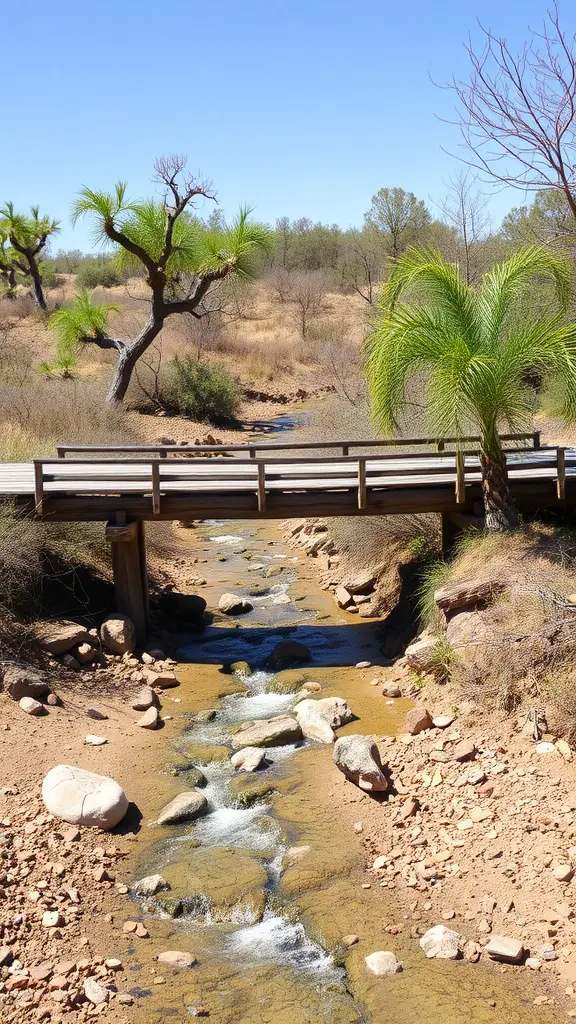
Wooden bridges can add charm and functionality to dry riverbed landscapes. They create a lovely focal point while providing a practical way to cross the stream below. The image shows a sturdy wooden bridge spanning a gentle water flow, surrounded by natural elements like trees and rocks.
These bridges blend well with the environment, enhancing the rustic feel of the landscape. They can be built in various styles, from simple planks to more elaborate designs with railings. The choice depends on your personal taste and the overall look you want to achieve.
Incorporating a wooden bridge can also encourage wildlife to visit your garden. Birds and small animals might be drawn to the water, creating a lively atmosphere. Plus, the sound of water flowing under the bridge adds a soothing element to your outdoor space.
When planning your bridge, consider the materials. Using treated wood can help it withstand the elements. You might also want to think about adding some lighting for a magical touch at night.
Gravel and Boulders Composition
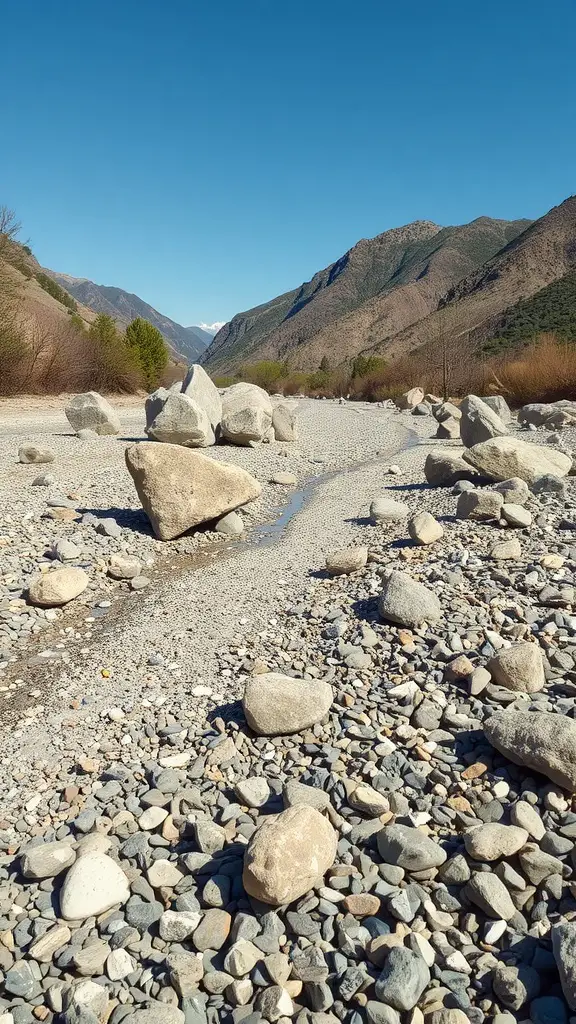
Creating a dry riverbed landscape can be both fun and practical. Using gravel and boulders adds texture and visual interest to your outdoor space. The image shows a serene riverbed lined with smooth stones and larger boulders, set against a backdrop of rolling hills. This natural look can transform any yard into a peaceful retreat.
Gravel comes in various sizes and colors, allowing you to customize your design. You can mix different types to create patterns or keep it simple with a uniform look. The boulders serve as focal points, breaking up the space and providing a sturdy structure. They can also be used to define pathways or borders.
Incorporating plants around the gravel and boulders can enhance the overall aesthetic. Drought-resistant plants work well in these settings, adding pops of color without needing much water. This combination not only looks great but also supports local wildlife.
Natural Stone Pathways

Natural stone pathways can transform a dry riverbed into a stunning landscape feature. The image showcases a winding path made of irregularly shaped stones, set against a backdrop of earthy tones and sparse vegetation. This design not only guides the eye but also invites exploration.
The stones are arranged thoughtfully, creating a sense of flow that mimics the natural curves of a river. This pathway is perfect for connecting different areas of your garden or yard, leading visitors through a serene environment. The combination of stone and surrounding plants adds texture and interest, making the landscape feel alive.
Using natural stones helps blend the pathway into the landscape, giving it an organic feel. This approach is great for those looking to maintain a natural aesthetic while enhancing functionality. Whether you have a small garden or a larger outdoor space, a stone pathway can be a beautiful addition.
Colorful Desert Flora

In a dry riverbed, vibrant desert flora brings life to the arid landscape. The scene showcases a mix of colorful cacti and blooming flowers, creating a stunning contrast against the sandy earth and rocky terrain.
Bright yellow and pink flowers pop against the green of the cacti, making the area feel lively and inviting. This combination of colors not only enhances the beauty of the landscape but also highlights the resilience of plants that thrive in harsh conditions.
Using similar plants in your own dry riverbed can create a beautiful and low-maintenance garden. Consider incorporating cacti and succulents that are suited for your climate. These plants require minimal water and can add a unique touch to your outdoor space.
Seasonal Color Changes
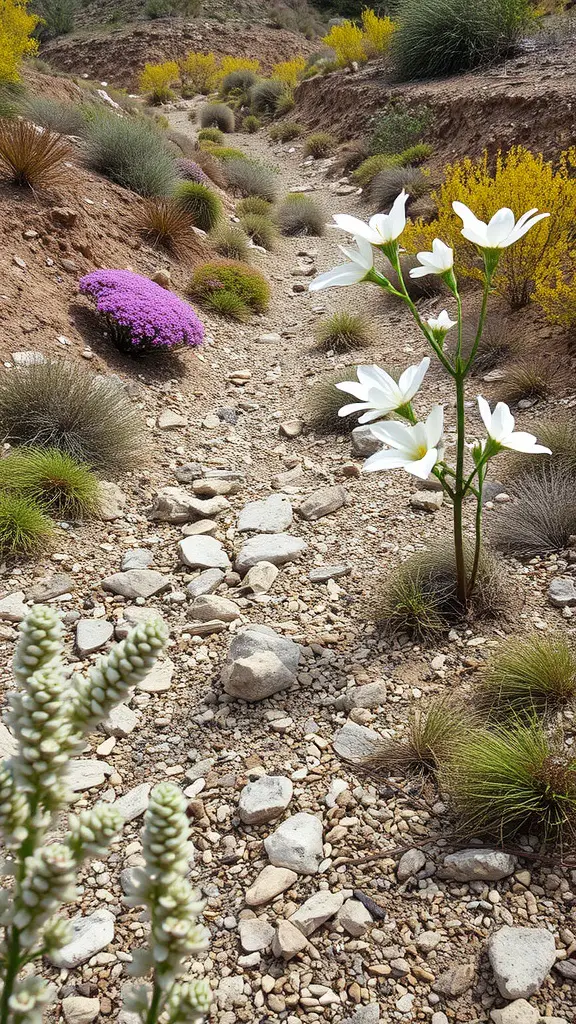
In a dry riverbed landscape, seasonal color changes bring a lively touch to the environment. The image showcases a winding path lined with various plants, each contributing to a vibrant palette. Bright yellow blooms and soft purple flowers pop against the earthy tones of the rocks and soil.
As seasons shift, the colors evolve. In spring, you might see bursts of purple and white flowers, like the lilies in the foreground. Summer can bring lush greens and yellows, while autumn introduces warm hues of orange and red. This dynamic display keeps the landscape interesting throughout the year.
Using plants that change with the seasons can create a beautiful and engaging space. Consider incorporating native species that thrive in dry conditions. They not only add color but also support local wildlife. This approach helps create a sustainable and visually appealing landscape.
Recycled Materials in Landscaping
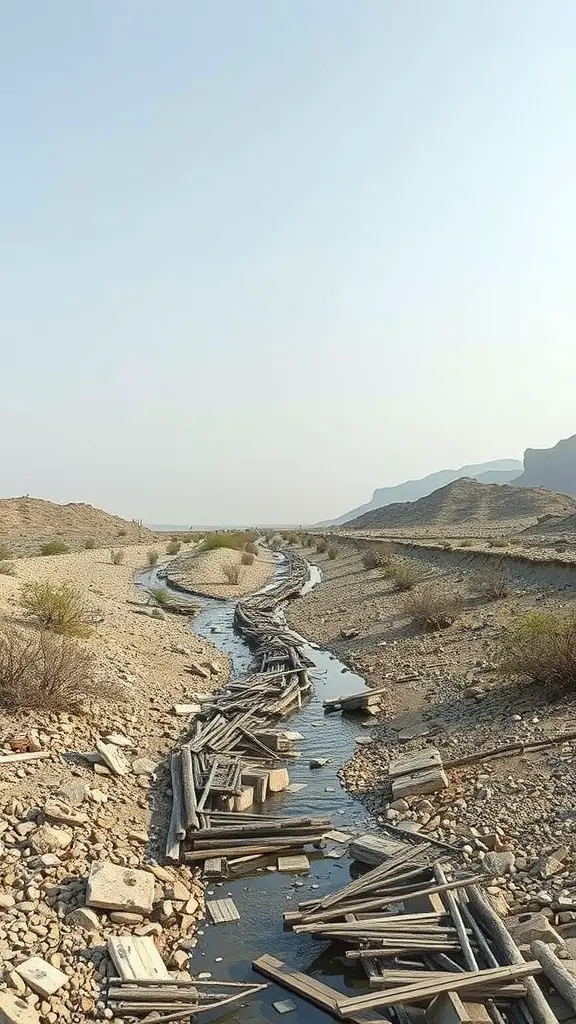
Using recycled materials in landscaping is a smart and eco-friendly choice. The image shows a dry riverbed lined with wooden planks and stones, creating a unique and rustic look. This design not only adds character but also makes use of materials that might otherwise go to waste.
Incorporating items like reclaimed wood, stones, and even old bricks can transform your outdoor space. These materials can be arranged to mimic natural features, like the winding riverbed seen in the image. It’s a great way to create pathways or borders that blend seamlessly with the environment.
Recycled materials are often more affordable than new ones, making them a budget-friendly option. Plus, they tell a story and add a personal touch to your landscaping. Whether you’re building a garden bed or a decorative feature, consider how you can use what you already have.
Pathway Lighting Options
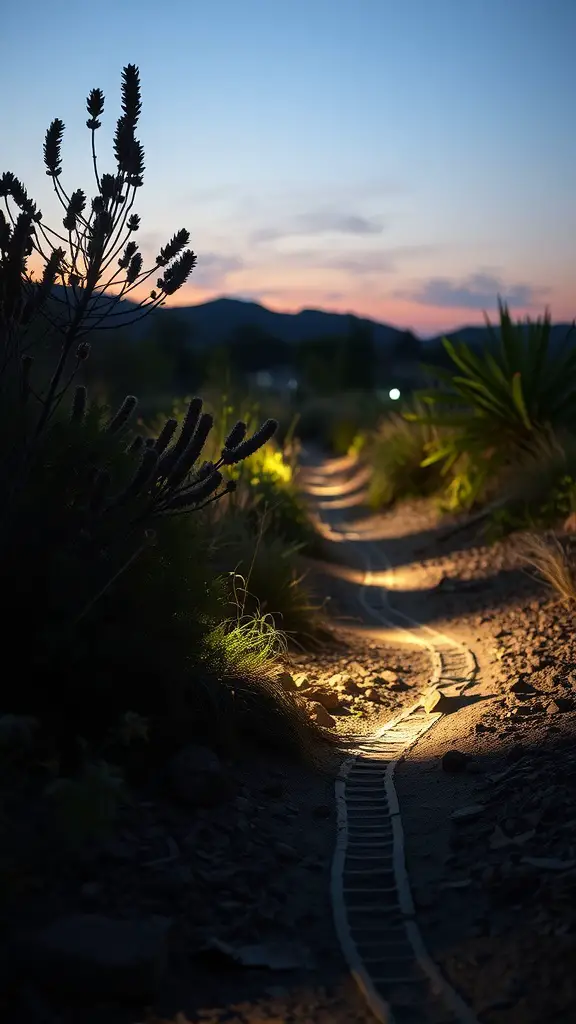
Creating a stunning dry riverbed landscape can be enhanced with the right pathway lighting. The image shows a beautifully lit path winding through a natural setting, surrounded by plants and rocks. This kind of lighting not only guides the way but also adds a warm glow to the surroundings.
Using low-voltage LED lights along the pathway can highlight the unique features of your landscape. These lights are energy-efficient and come in various styles to match your design. You can choose from solar-powered options, which are easy to install and require no wiring, or traditional wired lights for a more permanent solution.
Consider using lights that are embedded in the ground or along the edges of the path. This creates a subtle glow that illuminates the way without being too harsh. The soft lighting can make evening strolls feel cozy and inviting, perfect for enjoying your outdoor space after sunset.
Incorporating pathway lighting into your dry riverbed design not only enhances safety but also adds character to your landscape. Whether you prefer a rustic look or something more modern, the right lighting can transform your outdoor area into a magical retreat.
Textured Ground Cover

Textured ground cover can transform a dry riverbed into a stunning landscape. The image shows clusters of vibrant green plants scattered among smooth stones and sandy soil. This combination creates a visually appealing contrast that draws the eye.
Using low-maintenance plants like succulents or ground-hugging varieties is a smart choice. They thrive in arid conditions and add texture without needing much water. The rocks scattered throughout the area not only enhance the look but also help with drainage, making it easier for the plants to flourish.
Incorporating different shapes and sizes of plants can add depth to your design. The rounded clusters in the image create a natural flow, making the space feel inviting. This approach allows you to enjoy a beautiful landscape while conserving water and reducing upkeep.
Artistic Stone Arrangements
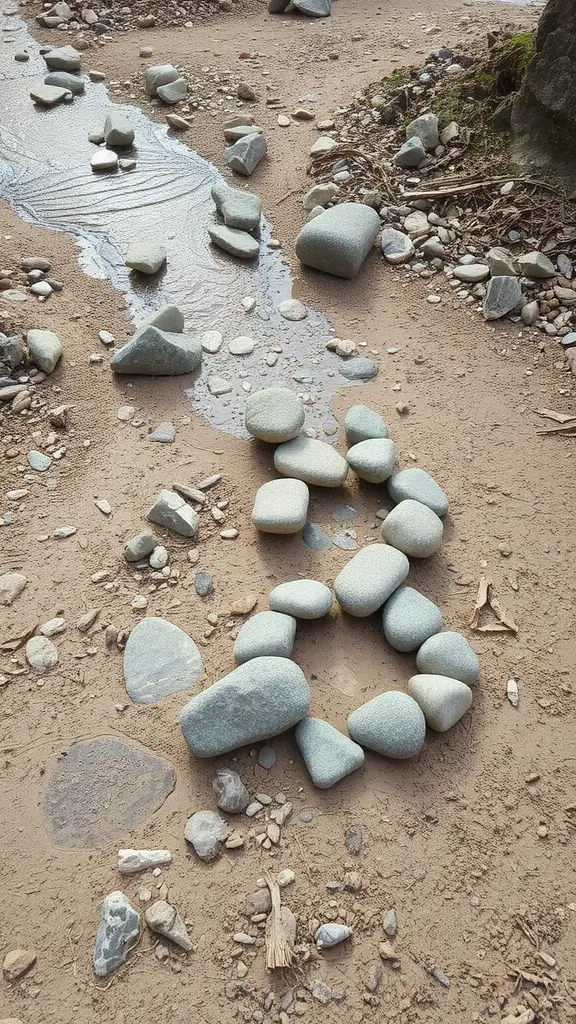
Creating artistic stone arrangements can add a unique touch to your dry riverbed landscaping. The image shows a collection of smooth stones arranged in a circular pattern, surrounded by various sizes of pebbles and sandy soil. This simple yet effective design draws the eye and creates a focal point in the landscape.
Using stones of different shapes and colors can enhance the visual appeal. The smooth, rounded stones in the image contrast nicely with the rougher textures of the surrounding pebbles. This variety adds depth and interest to the arrangement.
Consider placing your stones in patterns that mimic natural formations. This can evoke a sense of harmony and connection with nature. You might also want to incorporate some greenery or small plants around the stones to soften the look and create a more inviting space.
Wildlife-Friendly Features
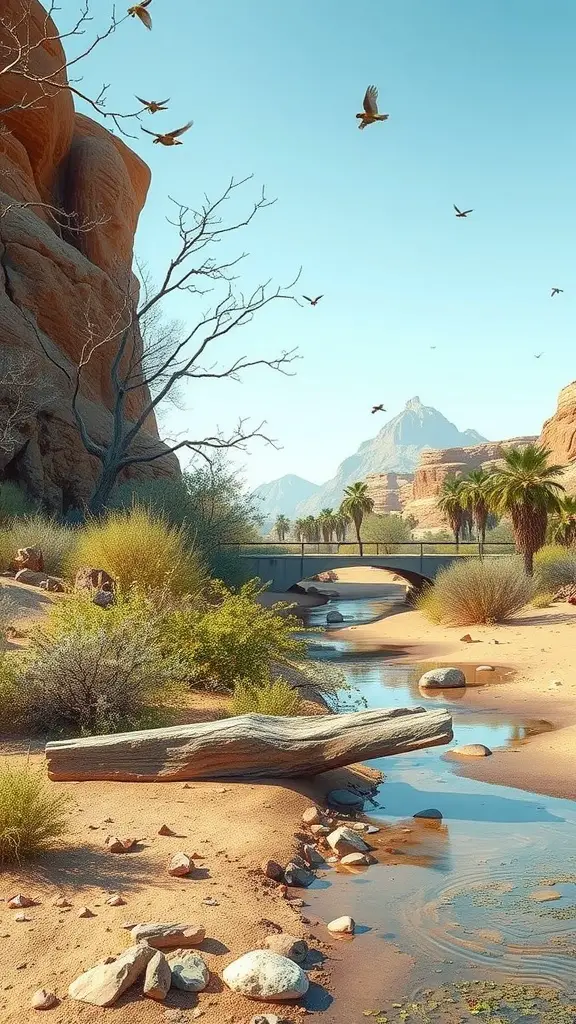
Creating a wildlife-friendly landscape in a dry riverbed can be both beautiful and beneficial. The image showcases a serene scene where nature thrives, even in arid conditions. The gentle flow of water, surrounded by lush greenery and rocky textures, invites various wildlife to visit.
Incorporating native plants is a great way to attract local birds and insects. The vibrant greenery in the image hints at a variety of plants that provide food and shelter. Consider adding flowering plants that bloom at different times to ensure a continuous food source for pollinators.
Water features, like the stream seen here, are essential for wildlife. They offer hydration and a habitat for aquatic life. Even a small pond can make a big difference. Adding stones and logs can create resting spots for birds and small animals.
Birdhouses and feeders can enhance the area further. The trees in the image provide perfect perches for birds, making it an inviting spot for them to nest. This not only supports local wildlife but also adds life and movement to your landscape.
Lastly, consider the layout of your space. Open areas mixed with dense plantings create diverse habitats. This balance encourages a variety of species to thrive, making your dry riverbed a true wildlife haven.
Zen Garden Elements

Zen gardens are all about simplicity and tranquility. The image shows a beautifully designed dry riverbed landscape that captures the essence of a Zen garden. The winding pathway, lined with smooth stones, invites a peaceful stroll through nature.
The use of gravel and strategically placed boulders creates a calming effect, perfect for meditation or reflection. The soft, rounded bushes add a touch of softness and contrast against the hard textures of the stones.
Incorporating elements like these can transform any outdoor space into a serene retreat. Whether you have a large yard or a small patio, a Zen garden can bring a sense of peace and harmony to your environment.


